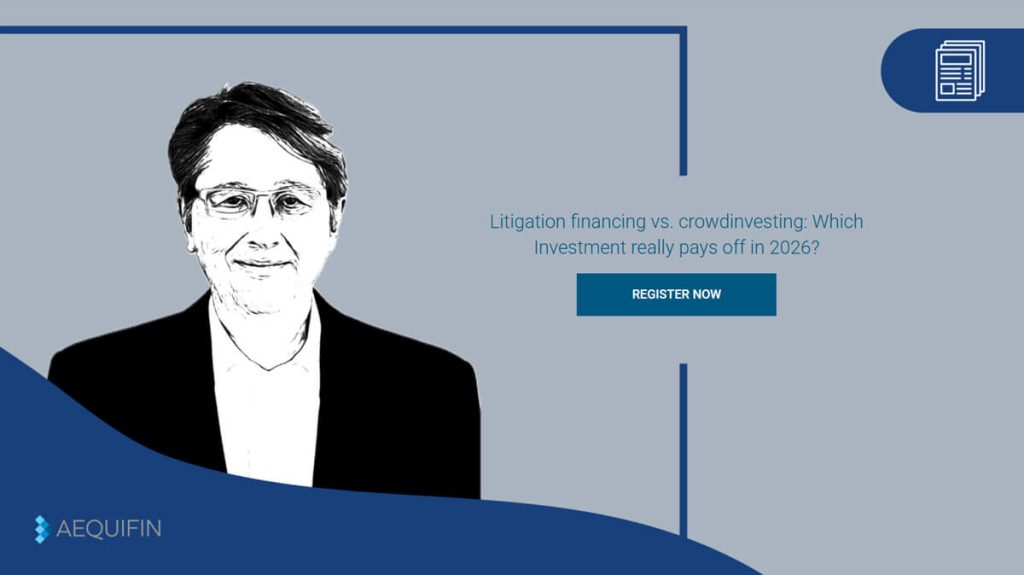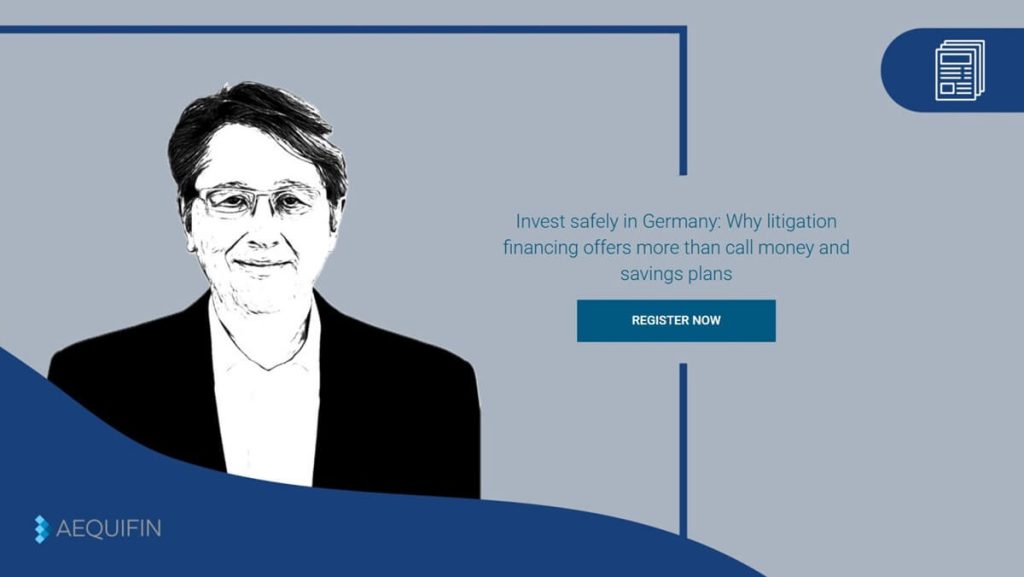The financial markets are currently experiencing a period of significant turbulence. In April 2025, President Donald Trump introduced sweeping tariffs, including a 145% surcharge on Chinese imports. This led to a massive drop in the stock markets. Within a few days, the Dow Jones stocks lost more than 4,000 points, and the S&P 500 recorded a decline of 10%. The total loss resulted in an astonishing 6 trillion US dollars in market value.
Such sharp declines have been rare. Since World War II, the S&P 500 has seen a two-day drop of more than 10% only four times, most recently during the 2008 financial crisis and the 2020 COVID-19 pandemic. In such an environment, investors are increasingly seeking more stable and predictable investment opportunities. A promising alternative is litigation financing, which operates independently of stock market fluctuations and offers both financial returns and social impact.
1. Investing in Stocks – Understanding Opportunities and Risks
Stocks have been among the most popular asset classes for decades. On the one hand, they offer investors direct participation in the economic success of companies. On the other hand, they are known for high return potential. However, they also carry significant risks that not every investor is willing to take.
What happens when you invest in stocks?
When investing in stocks, investors purchase shares of companies and thereby become co-owners. The expectation is to generate attractive returns through price increases or regular dividend payouts. Expectation is the key word here—because in reality, profits cannot be calculated in advance.
In addition to buying individual stocks directly, there are other types of investments that make access to the stock market easier. The most popular include:
ETFs (Exchange Traded Funds) that replicate entire indices like the DAX or the S&P 500.
Mutual funds actively managed by fund managers—these are typically geared more toward older or conservative investors.
Classic individual stocks, where investors specifically invest in selected companies.
What risks are associated with investing in stocks?
Despite the opportunities, stock investments involve significant risks. Price fluctuations caused by global economic developments, political decisions, or unexpected crises—such as the recent impact of new tariffs are part of the game.
Moreover, success strongly depends on the investor’s knowledge and timing. Many investors don’t fail because of the market itself, but due to psychological factors. Panic selling during crises or jumping into hype investments at peak prices often wipes out potential gains. This behavior is especially common among beginners—maybe even you?
The biggest risks when investing in stocks are…
- Market volatility due to economic shifts and crises
- Political interventions such as tariffs or sanctions
- Lack of knowledge and insufficient preparation
- Psychological mistakes like panic selling or following hype
- Poor timing when buying or selling
How much effort does it take to start investing in stocks?
If you want to invest in stocks, you should expect a certain level of effort. A solid understanding of markets, company fundamentals, and investment strategies is essential. Reading a few financial articles won’t cut it. But that’s just the beginning.
You also need to continuously monitor market developments, stay up to date with news, and adjust your investment decisions accordingly. Even with modern tools, apps, and low-cost trading platforms, fees and time investment can significantly impact your returns in the long run and cost you a great deal of time.
Today, entering the stock market is easier than ever thanks to various brokers and low barriers. But the real challenge is to invest wisely, consistently, and profitably—with as little time as possible. For many with a full-time job or a family, that’s nearly impossible. Maybe even for you. So what options do people like that have?
2. Litigation Financing as an Alternative Investment
Anyone who doesn’t want to expose their capital entirely to stock market fluctuations looks for alternative investment opportunities. One of them is litigation financing – also often referred to as litigation funding. Both terms describe the same concept. Third-party investors cover the legal costs of a lawsuit and, in return, receive a share of the proceeds if the case is successful.
Originally limited to institutional investors, litigation funding is now becoming increasingly accessible to private investors, offering attractive returns with low correlation to traditional markets.
This approach isn’t about chasing fast stock gains. It’s about predictable returns and contributing to a sustainable social impact. Still, the return potential can reach up to 10x the invested capital.
For comparison: the S&P 500 has historically taken around 30 years to achieve the same.
What is litigation financing?
With litigation financing, investors cover the costs of legal proceedings.
In return, if the case is successful—through a favorable verdict or a settlement—they receive a share of the financial outcome. A very straightforward concept, which is increasingly being discovered by a growing number of investors.
What makes this special: if the plaintiff loses the case, the investor suffers no financial loss. Thanks to the so-called non-recourse principle, the investor risks only their own capital, not the legal costs of the opposing party. This unique structure makes litigation financing an investment with clearly calculable risk.
Why Investing in litigation financing is attractive in 2025
Especially in times of political and economic uncertainty, litigation financing is gaining appeal. Unlike stock investments, its success does not depend on stock market performance, economic trends, or geopolitical tensions. Let’s be honest: the stock market is more volatile than ever. But with litigation financing, that volatility doesn’t apply.
Every investment also contributes to something bigger. It gives plaintiffs access to justice who otherwise wouldn’t be able to afford it. In this way, litigation financing combines return potential with sustainable social impact. You can help fund legal actions that otherwise would never see the light of day.
- A small local retailer sues a global giant like Samsung for wrongful contract termination.
- An expectant mother takes legal action against her former employer after an unjust dismissal.
- A startup fights a major investor who blocks innovation and misuses patents.
✓ Only cases with a high likelihood of success are funded.
✓ Risk is assessed in advance by legal experts and minimized.
✓ Return potential can be calculated in advance using a litigation cost calculator.
“At AEQUIFIN, not a single case has been lost out of more than 100 funded legal proceedings.”
Who can invest in litigation financing?
In the past, access to litigation financing was limited to large institutional investors.
Today, private investors can participate with minimal capital, making litigation financing more accessible than ever.
For the first time, litigation financing platforms offer an easy way to get started without requiring in-depth legal knowledge or large financial commitments. On the website, current cases open for funding can be viewed easily and transparently.
✓ Private investors looking to diversify their portfolios and explore new markets
✓ Family offices and wealth managers seeking stable sources of return
✓ Institutional investors wanting to invest in legally vetted proceedings such as litigation funding
✓ Impact investors aiming to generate both financial returns and social value
IN JUST 5 MINUTES:
3. Comparison – Stocks vs. Litigation Financing
| Criterion | Stocks | Litigation Financing |
|---|---|---|
| Return potential | High but volatile | Moderate but more predictable |
| Risk factor | Market psychology, global conditions | Legal case assessment |
| Availability | Tradable anytime | Tied to case duration |
| Entry requirements | Knowledge, timing | Case selection by experts |
4. Smart diversification with stocks and litigation financing
Litigation financing is an excellent way to broaden your investment strategy. While investing in stocks can offer high returns, it also comes with major fluctuations. Litigation funding, on the other hand, represents an independent risk class. Smart diversification is characterized by several key factors:
✔️ Spreading capital across different asset types and investment classes
✔️ Protection against market volatility and political events
✔️ Inclusion of alternative investments that operate independently of stock market trends
Discover the benefits of funding litigation cases on AEQUIFIN!
✔️ Start investing from as little as €1
✔️ Invest in vetted legal cases
✔️ Minimize risk – unlock return potential
👉 Register now for free and secure alternative investments for your portfolio.














